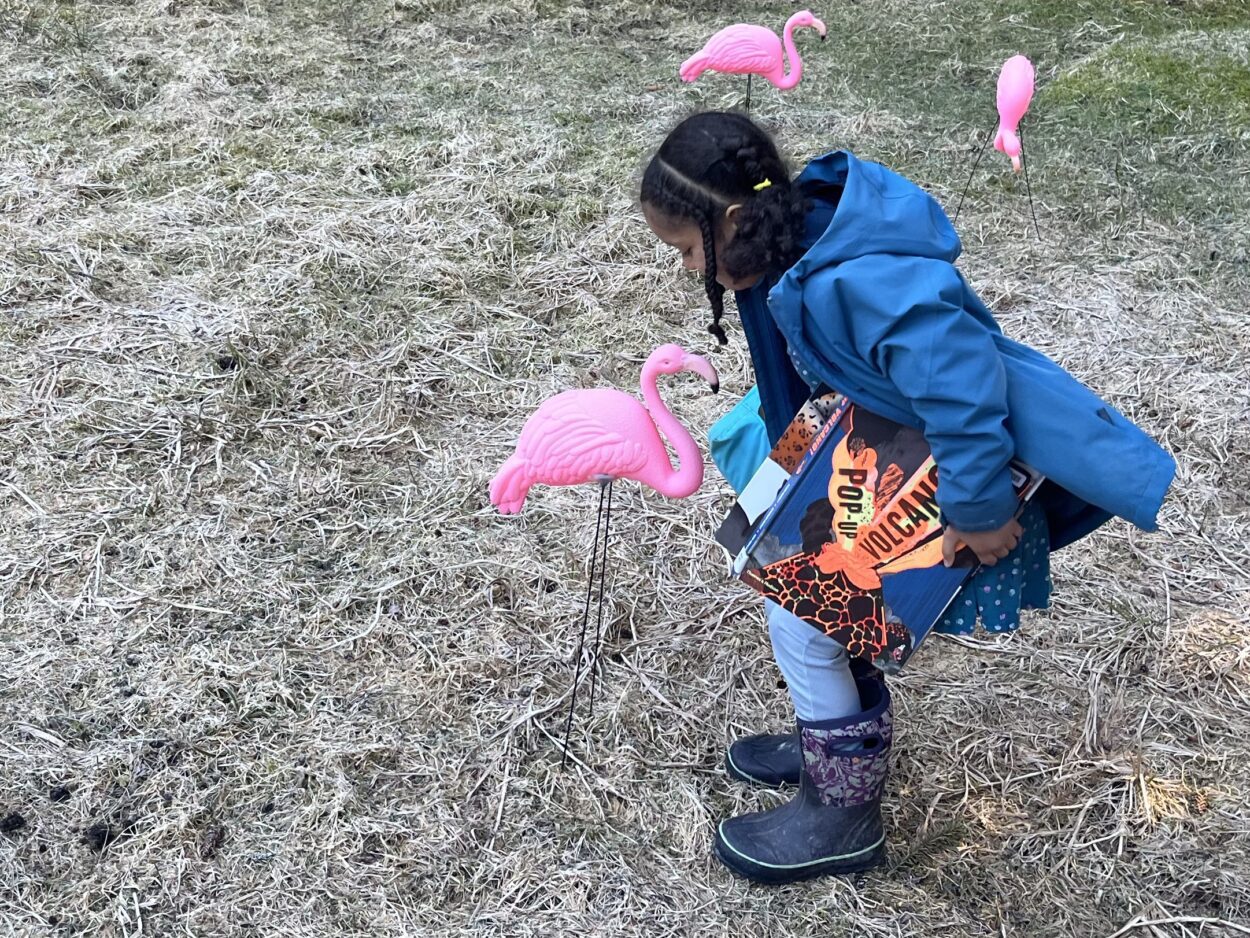
Petersburg resident Annika leans down to kiss one of the flamingos from the visiting flock. (Photo by KFSK)
Rogue dog packs in Petersburg used to be a problem. But for fifteen years, the nonprofit Petersburg Humane Association has cared for the town’s stray dogs and cats. And for the last decade, the organization has relied on a flock of non-native birds to help them do their work. KFSK joined Director Mary Clemens to witness this year’s spring migration.
It’s six in the morning and we’re in Mary Clemen’s silver station wagon, driving to the first pickup spot.
“Some blockers like to come in at the dark of night,” says Clemens. “I just as soon do it in the morning.”
She picks up a broken flamingo.
“He’s a little droopy,” says Clemens.
The birds’ Latin Name is Phoenicopterus Ruber.
But these ones are made of plastic. Think classic pink flamingo lawn ornaments popular in 1960’s Florida. Residents pay $10 for a flock of about ten flamingos to visit a yard for the day—surprising friends of family with the avine visitors. Right now, Clemens is picking them up to deliver them to their next destination. She tells me about the flocks.
“There are two that are active right now,” says Clemens. “And we do have a partial third one for flamingos that get damaged. Last year, Jean Smith went to go pick up a flock and it was gone. So we used the third flock to flock that day. They finally appeared out the road and somebody brought them back.”
Laura Wong-Rose is a board member for the organization.
“When the flamingos come out, you know spring is here,” says Wong-Rose.
She says fifteen years ago, Petersburg’s streets felt very different.
“Apparently, we used to have packs of dogs roaming around town terrorizing children, and a pretty large feral cat community,” says Wong-Rose.
The dogs were pooping all over downtown streets, attacking leashed dogs, and hunting deer—giving chase until the deer died from exhaustion or fled into the water and drowned.
“It was kind of dangerous to be outside sometimes,” says Wong-Rose.
So, a group of residents banded together to tackle the issue head-on, forming the Petersburg Humane Association. Merilee Jones led their first meeting, backed by the town’s then-veterinarian, Dr. Jane Egger.
Wong-Rose says the biggest way that the association helps with stray animals is through prevention.
“We do that through offering spay/neuter scholarships,” says Wong-Rose. “So, for folks that have pets, lower income that need assistance, the scholarships are available. Most of our fundraising and outreach goes toward that program right now.”
Spaying or Neutering a pet is not cheap. And Wong-Rose says that COVID pushed up the price of the operations.
“On average, a spay or neuter can run anywhere in the $400 up to 1200 dollar range, depending on the type of pet,” says Wong-Rose.
Petersburg Humane Association is independent, meaning it’s *not* connected with any other humane associations. So, they rely on two annual fundraisers to raise money. Besides flocking flamingos, they publish a yearly calendar with photos of Petersburg’s pets. And Petersburg *loves* its pets. Local dog owners have, on average, three dogs per household, according to Wong-Rose.
“So, lots of dogs in town,” says Wong-Rose. “And the dog population is increasing, it seems.”
The association maintains a dog park near the beach with volunteer help. And they run a no-kill shelter. Volunteers help care for puppies and kittens. And the organization keeps a list of families willing to foster animals temporarily.
Clemens and I pull up in her car to the house where the flamingos will loiter all day. We close the car doors silently so we don’t ruin the surprise. It’s a lawn with a chain link fence around it on Nordic Avenue—a main street in Petersburg.
“It’s a perfect yard because every place I push them down, they’re going in,” says Clemens. “Sometimes it’s not so easy to find places to stick them. This is just great.”
The two flamingo flocks will migrate around Petersburg through the end of April. And then, they’ll disappear as suddenly as they appeared—signaling spring is really here.









